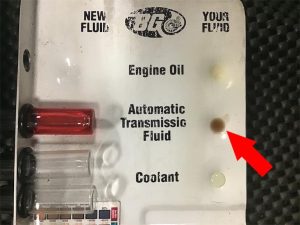
Transmission fluid is a super slippery liquid that lubricates all of the moving parts inside your transmission. In automatic transmissions, this fluid also acts as a coolant and a viscous fluid that transmits power from the engine to the transmission.
Low transmission fluid can cause serious damage to your engine. Here are some symptoms to look out for:
Trouble Shifting Gears
If you notice that your gears feel stiff or sticky, you could be low on transmission fluid. Low fluid will slow the cause the response time from gear shifting to become increasingly slow and difficult over time. You may even hear a light knocking sound if the problem becomes dire. The hydraulic pressure has to be precise for the gears to change smoothly in an automatic transmission—a lack of fluid will disrupt the rhythm of the shifting timing so it's important to come in for service right away.
Delayed Gear Engagement
If the lack of fluid is not addressed right away, you might also experience a significantly delayed response (sometimes up to 2 or 3 seconds) when you move the gear to “drive” or “reverse." This is called "delayed gear engagement." Low level of fluid can cause a delay in gear change, creating an extended pause between shifts and a jolt when the gear finally clicks into place.
You might also find that your gears slip out of place, meaning the transmission doesn’t stay in the mode you have selected. That is a more severe symptom, typically caused by low transmission fluid or debris in the system.
Overheating
The main function of the transmission fluid is to keep the transmission temperature at a normal level, particularly in automatic vehicles. If the transmission fluid is too low, there won't be enough lubrication for all of the transmission's components; this causes a huge amount of friction which can lead to overheating. Overheating will cause delayed shifts, gear slippage, loss of engine power, and can even create a pungent burning smell or trigger a check engine alert.
How to Check for Low Transmission Fluid
If you notice any of the symptoms mentioned above, you can check the transmission fluid level using a dipstick. Most dipsticks have a general guide etched into them for quick reference but you should always double-check your owner's manual to see what the appropriate levels are.
As a general rule of thumb, it's a good idea to check the transmission fluid level at least once a month. If it is too low, if it changes in color (i.e. becomes brown or black), or if you noticed a burning smell, you should bring your car in for service right away. Bad transmission fluid can lead to serious transmission issues if not replaced right away.
At V&F
Driving with a failing transmission can cause catastrophic damage to your engine-- and leave you in a tight spot if it conks out on the road. As soon as you notice your car is leaking transmission fluid or experiencing trouble, you should contact a certified mechanic for a transmission repair. The faster you get it fixed, the fewer problems you will have with your vehicle in the future.
At V&F, we offer transmission repair, rebuild, or replacement for when a simple transmission flush or maintenance service doesn't solve the issue.
Call us at (413)314-2280 or
schedule an appointment online.
 Transmission fluid is a super slippery liquid that lubricates all of the moving parts inside your transmission. In automatic transmissions, this fluid also acts as a coolant and a viscous fluid that transmits power from the engine to the transmission.
Low transmission fluid can cause serious damage to your engine. Here are some symptoms to look out for:
Transmission fluid is a super slippery liquid that lubricates all of the moving parts inside your transmission. In automatic transmissions, this fluid also acts as a coolant and a viscous fluid that transmits power from the engine to the transmission.
Low transmission fluid can cause serious damage to your engine. Here are some symptoms to look out for:
